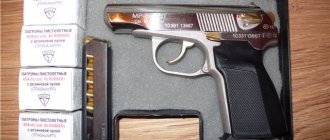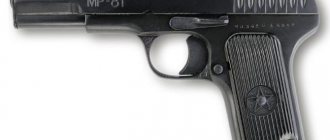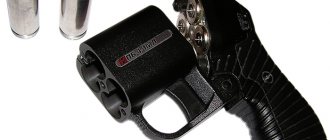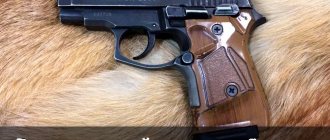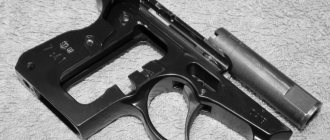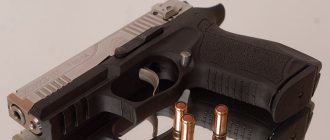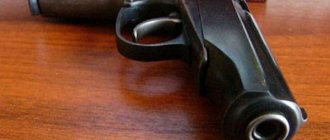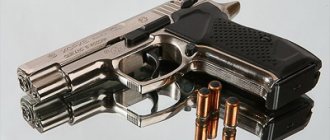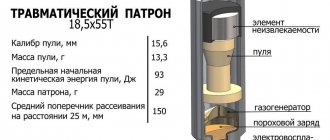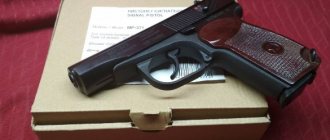When gun connoisseurs hear the phrase “German Mauser HSc pistol,” what comes to mind is the famous self-loading pistol from the First World War. Everyone understands that this is a time-tested weapon of excellent quality. And indeed it is.
The Mauser HSc has established itself as an excellent example of a military weapon, despite the fact that it was at one time in service with the Third Reich. The Germans stopped its production back in 77 of the last century, and the combat Mauser remained only in history. The modern history of weapons, the history of trauma in particular, knows another example of the German “Mauser”. This is the “Mauser HSc 90t” - a traumatic pistol manufactured in 2005, German, but different), released to the “people” during the heyday of traumatic weapons.
Traumatic pistol "Mauser HSc 90t" - a weapon of German quality
When gun connoisseurs hear the phrase “German Mauser HSc pistol,” what comes to mind is the famous self-loading pistol from the First World War.
Everyone understands that this is a time-tested weapon of excellent quality. And indeed it is. The Mauser HSc has established itself as an excellent example of a military weapon, despite the fact that it was at one time in service with the Third Reich. The Germans stopped its production back in 77 of the last century, and the combat Mauser remained only in history. The modern history of weapons, the history of trauma in particular, knows another example of the German “Mauser”. This is the “Mauser HSc 90t” - a traumatic pistol manufactured in 2005, German, but different), released to the “people” during the heyday of traumatic weapons.
Design
The pistol is self-loading and operates on the blowback recoil principle. Double action trigger mechanism. The magazine is box-shaped, with a single-row arrangement of cartridges.
There are three protrusions in the barrel bore, eliminating the possibility of firing a live cartridge. Another difference between the traumatic Mauser HSc mod.90T and the gas pistol Mauser HSc mod.90 is the presence of a transverse pin for fixing the trigger guard.
The weapon has low mechanical strength, since the main parts are made of powder alloy (silumin).
Description
The Mauser HSc pistol is a self-loading pistol, built on an automatic blowback mechanism and having a double-action trigger mechanism. Among the design features, the following should be noted: The barrel is fixed to the frame using a latch located inside the trigger guard, and can be removed during disassembly. The return spring is located around the barrel. The trigger is almost completely hidden by the bolt, and only a small flat spoke protrudes outward, allowing you to cock the trigger manually if necessary, but practically eliminating the possibility of the trigger catching on clothing when snatching the weapon. In addition, this design reduces the likelihood of dirt getting inside the weapon. The safety is located on the left side of the bolt and when engaged (lower position), it moves the rear of the firing pin away from the hammer and blocks the firing pin, so that an accidental shot is completely eliminated. The shape of the pistol and sighting devices are also optimized for concealed carry: the low-height front sight is hidden in a longitudinal groove made in the bolt and does not protrude beyond the contour of the weapon, also reducing the possibility of it getting caught on elements of clothing or equipment when removing the pistol. The magazine release is located at the bottom of the handle; the magazine holds 7 or 8 rounds, depending on the caliber. Overall, the Mauser HSc is a very successful example of a compact weapon for self-defense and concealed carry.
Modifications
Since 1896, the Mauser pistol has been manufactured for various types of cartridges, in an incredible number of samples. Until 1912, Mauser managed to produce 22 different models.
- "Mauser K-96". Sample 1896. Equipped with a conical striker, a long extractor, and a relief surface. Designed for 6, 10 and 20 charges. The numbers are one- and five-digit.
- "Mauser K-96". Sample from 1899. Equipped with a striker with a large ring, a relief surface and a long extractor. Has a five-digit number.
- "Mauser K-96". Sample from 1899. This “flat” has a smooth surface, a striker with a large ring, and a five-digit number. Manufactured under contract for the Italian Navy and other commercial structures.
- "Mauser K-96". Model 1904. This is a young, pre-war transitional example numbered 34xxx, equipped with a small ring and a long extractor.
- "Mauser K-96" 1905. This is a pre-war product equipped with a small ring placed on the striker and a short extractor.
- "Mauser K-96" 1912. This sample has a smaller and lighter trigger, a wider and shorter ejector, and a slightly weakened return spring. It is equipped with a barrel with six rifling. It is noteworthy that earlier modifications have four grooves on the barrel. The head of the safety lever of this model does not have a hole. The trigger on the back is marked “NS”. This is the most popular sample. The nine-millimeter Mausers and Bolo Mausers were manufactured on its basis.
- "Mauser K-96" 1916. This option is made for a charge of 9 X 19 mm. This Parabellum was created for the German army. The red number 9 is painted on the handle of this product. By the way, after the end of the First World War and the initialing of the Versailles Treaty, Germany was prohibited from creating pistols with a long barrel - more than 100 mm.
- "Mauser K-96" 1920 release. They called him “Bolo” - “Bolshevik”. This option was created for 7.63 X 25 mm cartridges. Equipped with a barrel reduced to 99 mm. This product features a short walnut grip with 22 grooves and a Small Ring Hammer trigger with NS stamp. The basic difference of the sample is the horizontally swinging swivel on the handle. Most of these products were purchased by Soviet Russia.
- "Mauser K-96" 1932. This model #712 is called Schnellfeuer. It is an automatic version of the Mauser, equipped with a 20-round magazine. In automatic mode, it can fire about 850 shots per minute.
MP 153
From the first shots it became clear that the MP is very picky about cartridges - there is a very large spread. Preliminary conclusion: you won’t be able to shoot long distances with this gun. I spent a long time selecting cartridges, shooting regular ones, reinforced ones like semi-magnum with a 36g shot load, 76mm magnum, changing the shot number, powder charge weight, shot weight, changing nozzles (factory) - to no avail, well, maybe my requirements are too high or the barrel is not broken in enough, but over time nothing changed for the better. And my former double-barreled shotgun was omnivorous in terms of accuracy. Well, how could it be, in a word, I was very disappointed.
And somehow after school, after the 2nd year in 2006. did an internship in a subpolar town where there was only one hunting store. I looked in, and on the display case, next to the same standard nozzles as mine, there was an elongated nozzle.
After installation and shooting with various cartridges, I finally found the golden mean - a container semi-magnum with a 36g load, shot number 5. And that’s it, a completely different picture - the hunting efficiency has increased significantly. Unfortunately, with a good fight there are also disadvantages, well, what would we do without them: rather large dimensions due to the elongated barrel; a lot, it’s a bit heavy for me, especially when I have to do multi-kilometer hikes where equipment simply won’t fit. The dimensions are fixable, you can look for a folding stock, or come up with something, it’s quite possible to play tricks yourself at home, there’s nothing on YouTube. The factory stock turned out to be not very practical for me, well, this is individual for everyone, it depends on the body type, in the future I plan to look for something better. You can tune it in the form of various attachments, larger-capacity magazines, buy a cat's eye, a collimator, an under-barrel flashlight, but this all somehow smacks of show-off, again the weight of the gun increases, unless the weight of the wallet decreases.
Approximately in the second year, cracks appeared in the places where the gas piston was attached to the bolt rod, but so far it’s holding up; if anything, it won’t be difficult to find the piston (the price is within 1000 rubles).
Apart from this case, there have never been any jams, in this regard this is a huge plus. There is an adjustment valve to adjust the trouble-free operation of the automatic, but there was no need for adjustment; I repeat, the gun is trouble-free, absolutely omnivorous to various weights of gunpowder. And finally, such important advantages as low recoil, ease of assembly and disassembly. I didn’t shoot bullets, they speak very well about the “paradox” attachment, for me personally there is no need for this because I have a Saiga 5.45x39 isp.8 rifled carbine for these purposes, but more on that later... And here is a photo (the picture was taken on a Lenovo P780) of my most productive hunt from back in 2015:
Performance characteristics of the Mauser K96 pistol
| Weapon weight, kg | 1,25 |
| Total length of weapon, cm | 31,2 |
| Barrel length, cm | 14 |
| Number of barrel rifling | 6, left-hand cutting |
| Cartridge | 7.63 x 25 mm Mauser |
| Initial bullet speed, meters per second | 425-435 |
| Cartridges in the store, pcs. | 6/10/20 |
| Sighting range, m | 1000 |
| Effective fire distance, m | 300 |
Possible tuning (upgrade)
What is better: a traumatic revolver or a traumatic pistol?
Since the pistol does not belong to the class of powerful gas-cylinder pneumatics, the main direction of its upgrade is related to increasing the initial speed of the bullet. A significant result is achieved by strengthening the mainspring, which provides the speed and force of impact on the valve, as well as boring the pneumatic chamber.
The Mauser S96 pistol is one of the brightest examples of gas-cylinder pneumatics, intended for recreational shooting and satisfying the need for an outdoor weapon. Compared to other models, the Legends C96 is a truly iconic pistol that captures all the drama of its predecessor's era. Review of the Mauser C96 air pistol:
Tactical and technical properties of the Mauser HSc pistol
Entered into service: 1940 In service………………………Germany Designer…………………Alex Siedel Manufacturer………………………Mauser Years of production………………………1940—1977 Total production……………………251,988 units Options…………………HSc Super Weight, kg…………………0.7 (without cartridges) Length, mm……………… ……152 Barrel length, mm…………………86 Cartridge………………….32 ACP; .380 ACP Operating mechanisms……………………blowback Type of ammunition…………………magazine for 8 rounds (.32 ACP); 7-round magazine (.380 ACP) Sight………………………open sight
Photo of the Mauser HSc pistol
Design of the Mauser HSc mod.90T pistol
The automation in the German gun is standard: it is built on a blowback system, and the return spring wraps around the barrel of the weapon.
The barrel itself received a very unusual design from German engineers: as many as three barriers were placed in its channel. But the peculiarity is that they are not located opposite each other, but at an equal distance from each other, dividing the trunk into three equal sections of 120 degrees. It is this unusual design that gives excellent accuracy of fire, which the Mauser HSc 90T has long proven in practice. Some owners also said that they came across models where there were only two obstacles, located in a mirror.
Despite the excellent accuracy, there is a small drawback that all potential buyers should be aware of. The fact is that the Mauser HSc mod.90T pistol cannot fire powerful cartridges. The use of “strong” charges will lead to rapid damage to the Mauser. Moreover, the breakdown will not occur in the usual place - the barrel, but in the bolt casing. This is explained by the fact that the pistol is made of light alloy metals.
Despite frequent failures of the bolt casing due to the use of powerful ammunition, trauma lovers from Russia found a way out. They managed to minimize the possibility of failure of the bolt casing, while using good cartridges. They decided that the standard cartridges in the Mauser HSc 90T could be replaced with 9 mm PA. The Mauser made excellent friends with these charges.
Firearms of limited destruction WASP-GROM
magazine “Hunting and Fishing. XXI century", October 2013
WASP-GROM is the most compact pistol on the Russian non-lethal weapons market (weight 0.37 kg, length 116 mm, thickness 23 mm). Designed for the use of the entire range of 9 mm RA traumatic cartridges. Magazine capacity 6 rounds. To lighten the weight of the weapon, the frame is made of aluminum. The shutter is phosphated steel (matte black) or nickel plated (matte light). Accessories: 8-round magazines, 8 and 9-round magazines with a handle extension for a tighter grip on the pistol.
"Master Gun" magazine, October 2013
In the summer of this year, the Klimovsky Specialized Cartridge Plant began production of firearms of limited destruction (OOOP) WASP-GROM, which, like its predecessor, the Czech WASP-R, is the most compact pistol on the Russian market of non-lethal weapons.
Externally, apart from the name and brands, the new WASP GROM pistol differs from the Czech WASP-R in its more massive, thick-walled barrel - the diameter of the bore has become smaller by 2.3 mm and amounted to 7 mm. The WASP-GROM barrel has welded lugs in the bore, and the barrel itself is one-piece, not composite, like its predecessor WASP-R.
If the muzzle end of the WASP-R ended with a 9.3 mm caliber with an effective appearance of “rifling” (in fact, these are traces of press-in liner with pressed protrusions), then the muzzle end of the WASP-GROM looks more modest - the bore diameter is 7 mm and a large chamfer. The WASP-GROM barrel is finally solid, and the lugs inside the barrel bore are welded. Of course, this increased, first of all, the operational strength of the weapon - a solid and thicker-walled barrel will withstand much more fire than a composite one.
WASP-GROM is adapted for firing all 9 mm RA traumatic action cartridges (PTD). with muzzle energy from 35 J to the maximum legally permitted 91 J. PTDs such as the AKBS Magnum and KSPP 91 J allow you to realize your potential almost to the maximum, while the cartridge case is ejected about a meter further than when firing 35 J cartridges. The characteristics of the WASP-GROM with powerful cartridges are slightly superior to the WASP-R with the same cartridges.
Unsurpassed compactness, ease of handling, high operational durability and maximum wearing comfort are the main components of the popularity of the WASP-R and the new WASP-GROM model.
The pistol is also interesting due to the possibility of quick transformation due to 9 charging magazines, the lower part of which extends the WASP-GROM handle and allows all the fingers of the shooting hand to be placed on it. This makes it possible, if necessary, by simply replacing magazines to obtain maximum compactness of the pistol or higher firepower.
chief technical consultant
Pavel Novichkov
Evaluation of the Mauser HSc 90t pistol as a weapon for self-defense
If we evaluate this traumatic pistol as a self-defense weapon, then it must be said that compared to other German traumatic pistols, it is a good example of a traumatic weapon.
The data speaks for this:
- The design is quite acceptable. Not handsome, but has the classic look of a “police” weapon;
- Convenient to use (the size of the handle fits any palm);
- Comfortable to wear at any time of the year (compact, has no protrusions, lightweight);
- High-quality assembly;
- Accuracy and excellent accuracy of combat when shooting (accurate even at a distance of 7-10 m);
- Reliable and little subject to wear (if you do not use high-power cartridges).
The downside is the material of manufacture, which again suggests a refusal to use charges with kinetics of more than 50 J.
In general, the “German” quality of the Mauser HSc 90t injury weapon makes it a good example of a self-defense weapon.
Comparison of Mauser C96 with analogues
In 1902, competitive tests were carried out on several personal small arms systems for arming the German army.
They included Mauser C96, Borchardt C93 and Luger P-08 pistols. Several other weapon systems took part in the tests, but due to extremely unsuccessful designs, their testing was not completed. Borchardt C93
It was a very successful pistol of its time. Traces of the design of this weapon can be seen in the Mauser S96 in question. But Borchardt’s pistol had one undeniable convenience - combat accuracy was achieved by the almost ideal weight distribution of the weapon, which was indirectly ensured by the cartridge supply system located in the form of a magazine in the handle.
The advantages of the pistol were the accuracy of the shot, the ability to use the holster as a butt, and ease of reloading.
The disadvantages were low resistance to dirt, the size of the weapon and its weight, as well as high cost.
Luger P-08
Being a kind of continuation of Borchardt's design, the Luger pistol managed to reduce the overall weight of the weapon and achieve great accuracy thanks to the handle with an anatomical slope and an easy trigger. The pistol used a cartridge of its own design, 9x19 mm Parabellum, with increased stopping power compared to 7.63 mm cartridges.
But it was not without its drawbacks - the Luger inherited an open-type bolt from the Borchardt system, which is extremely unstable to contamination.
general information
2004-2005 are considered the richest years for the traumatic weapons market. Moreover, then not only many types of these weapons appeared, but also many companies that were engaged in their production. In 2005, the Mauser HSc, produced by Rohm, entered the market. I brought a pistol to the Russian market.
Consumers reacted to it quite predictably: skeptically, with many doubts. The reason for this was that the gun was manufactured by the Germans and was not made entirely of steel.
Despite this, Mauser had a good advertising campaign, thanks to which buyers were found in sufficient quantities. There was no excitement only because the Internet began to appear at that time, people learned to write and read reviews on the Internet. Other people now helped the person avoid making the wrong choice.
"Gone just to freeze and die"
— How did the war begin for you?
“I learned about the war not in Moscow, but in the distant Moscow region, I was there with a geodetic team. We were told that the war had started only in the evening, when we came from the field. I remember sitting at the Kirishi station near Leningrad and waiting for some team of Red Army soldiers to let me onto the train. Finally they took me and I came to Leningrad. This was around June 27–28. Along the way I met my classmates who were being evacuated at that time. They saw me with my things and thought that I was going with them too, but I naturally ran home. Well, then...
- Blockade...
— The first months were the most terrible - this is until February - early March 1942. I was 13 years old. My family had experience of the Volga hunger strike, because there was a terrible famine on the Volga in 1921. My relatives lived near Samara at that time, they knew all this. Both of my grandparents died in 1921, eight years before I was born. Therefore, my mother, taught by this bitter experience, stocked up on some cereal. This supported us for some time. I remember that people were still meeting each other until about mid-September, then it became so bad that there was no longer any strength to communicate.
Now every year on May 9 they always show the parade of November 7, 1941, but they never tell what Stalin said to this parade. I lived in a communal apartment, my neighbors were the Nabokovs from that same family, and we all listened to his speech together. He then said: “Germany is already bleeding, Germany has lost 4.5 million soldiers,” that the war will continue for a month, three months, maybe a year. The entire communal apartment was discussing this, and, as you understand, no one believed this matter. But for people who would not believe him, he found a remedy in the same speech. He said something like this: “The war is not as terrible as some frightened intellectuals think.” So, if you didn’t believe this, then you are a frightened intellectual... After some time, a week and a half, everything in the city became much worse. Before this, people had never died of hunger, but now it all started.
— Did you have a big family?
- Four people. Two of them - my stepfather's grandfather and his wife - committed suicide. They were over 70 years old, people of that age could no longer stand it, and it was in December that they left the house. We were told that it seemed like cars were going around and picking up the dying. I haven't seen any such cars. I think they left just to freeze and die. My mother and I were left.
Well, then it got worse and worse until February. Then there was no water, no telephone, and, most importantly, no bread. We stood for bread. Sometimes it happened that he was not delivered on time, and therefore he had to stand until the evening or until the next day. They say that there was cannibalism, I have not encountered it, but once I saw human legs in the next entrance - bones from which the meat had already been trimmed.
